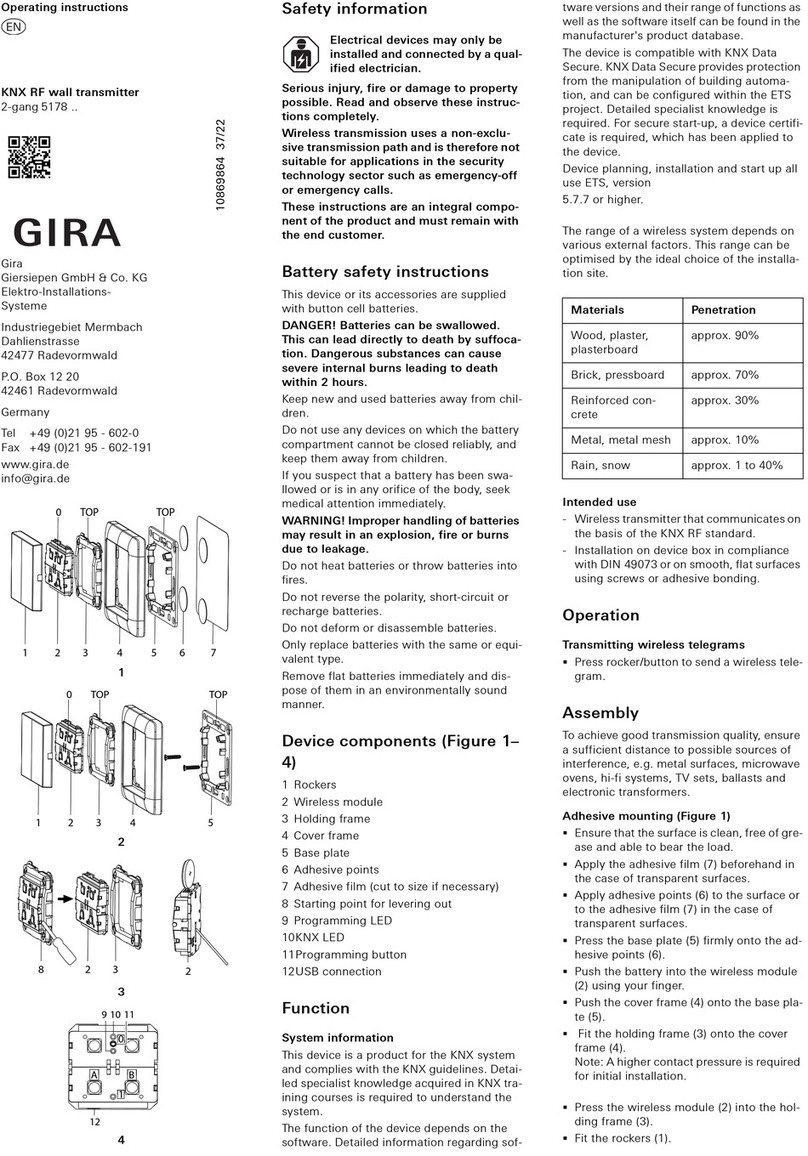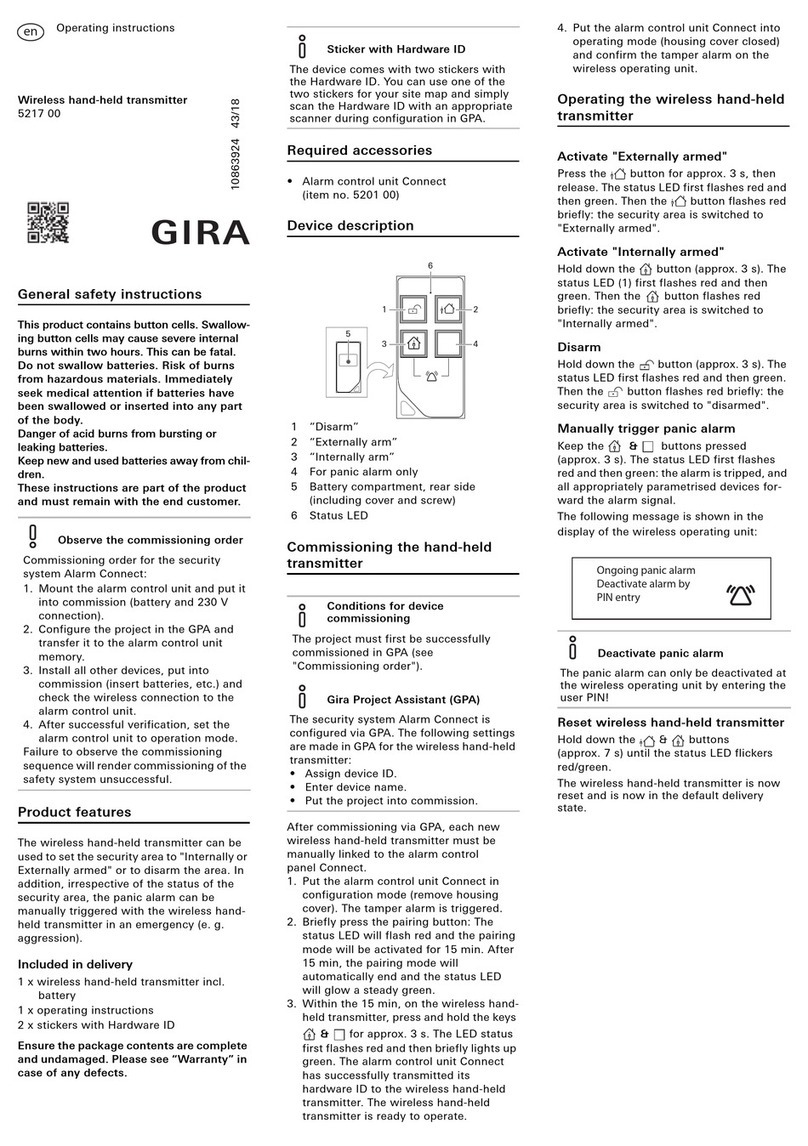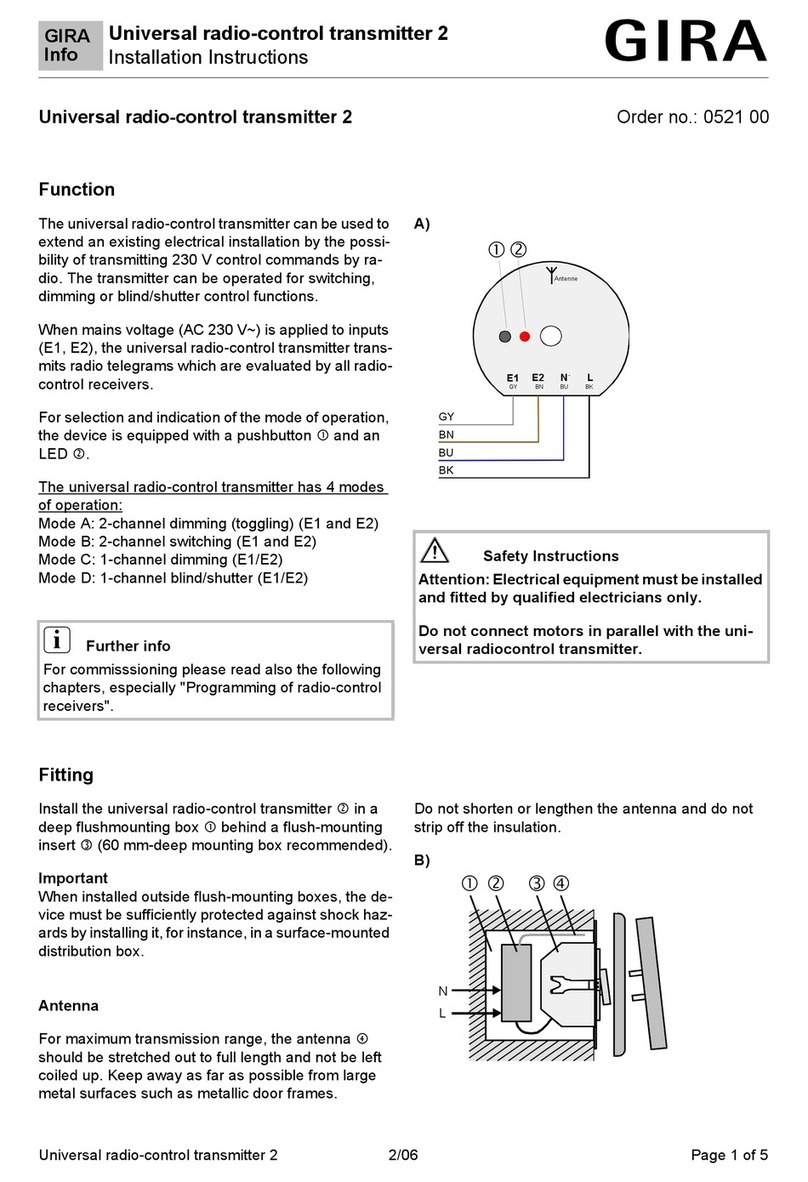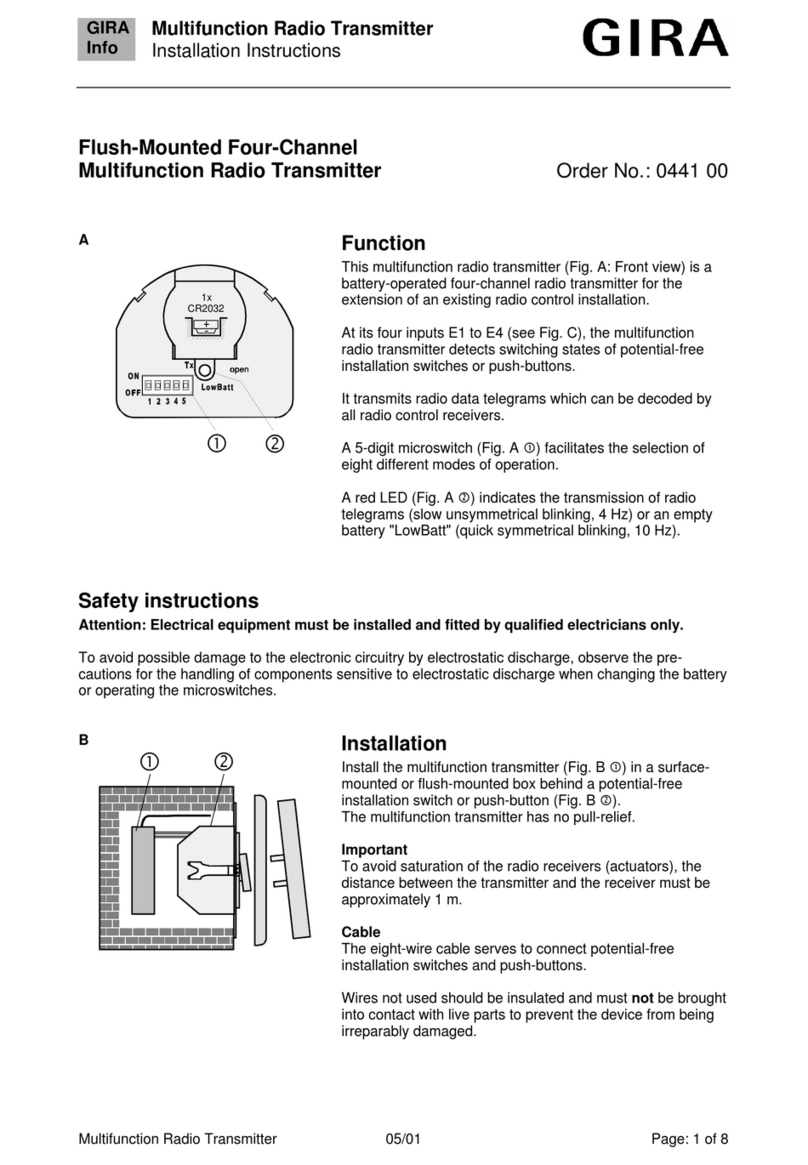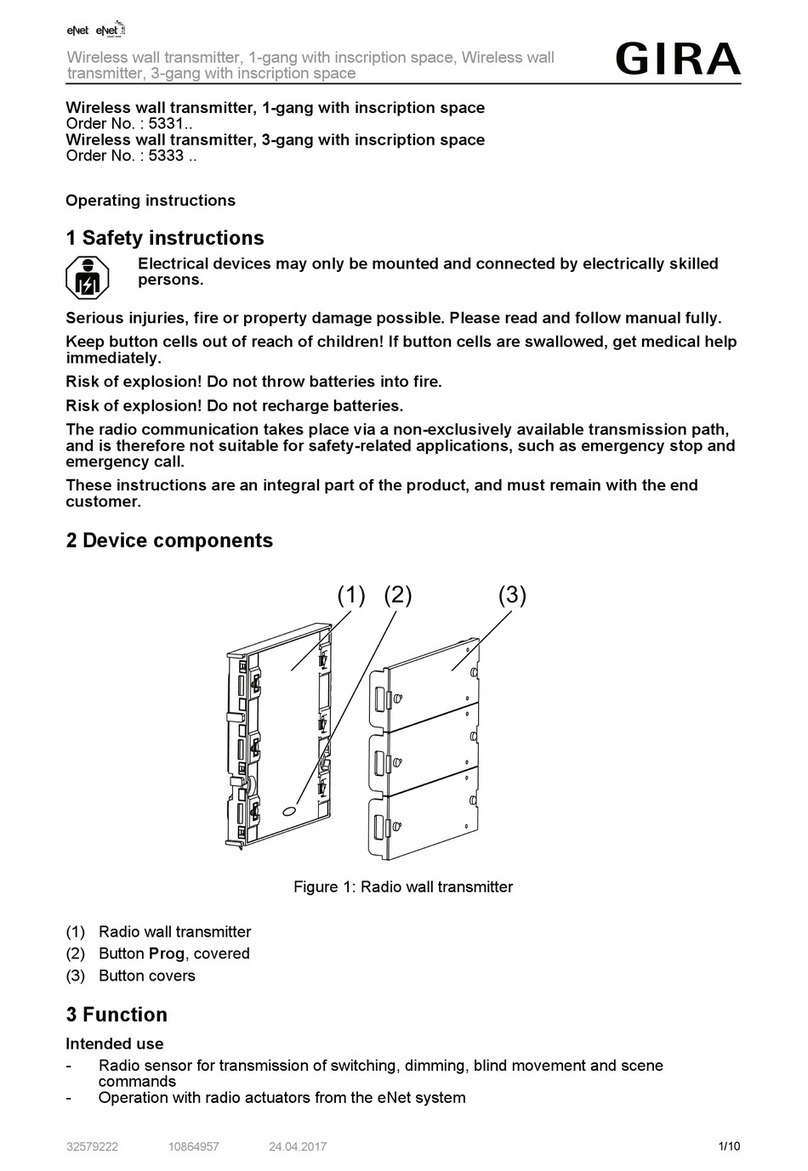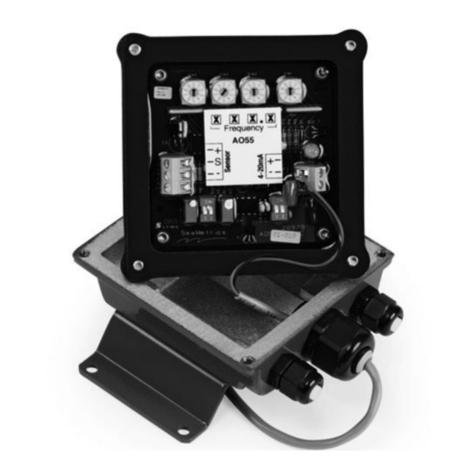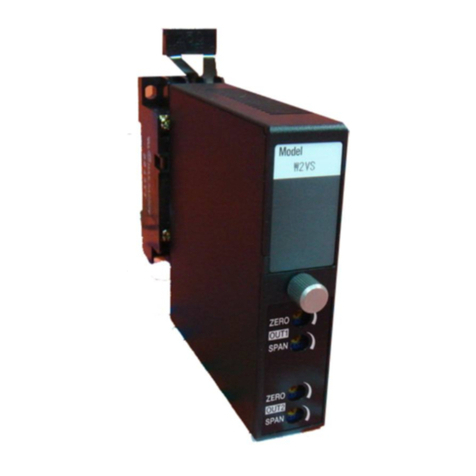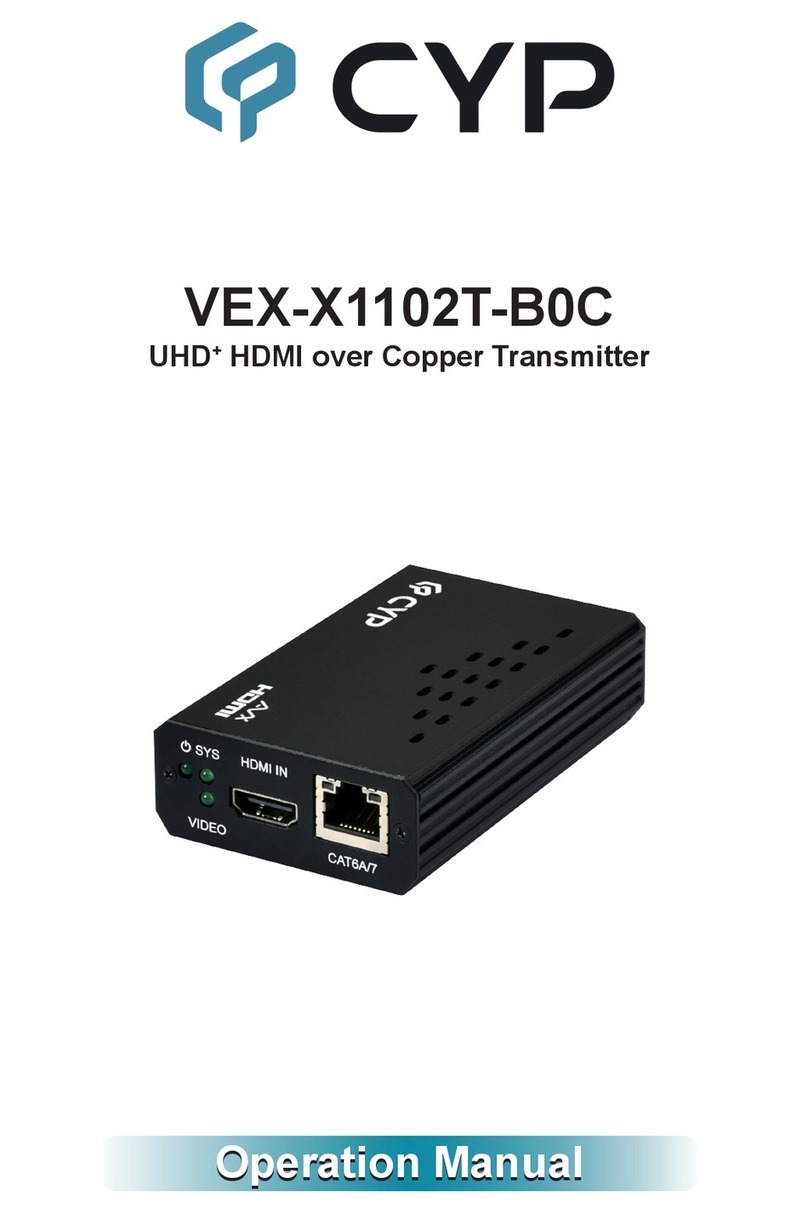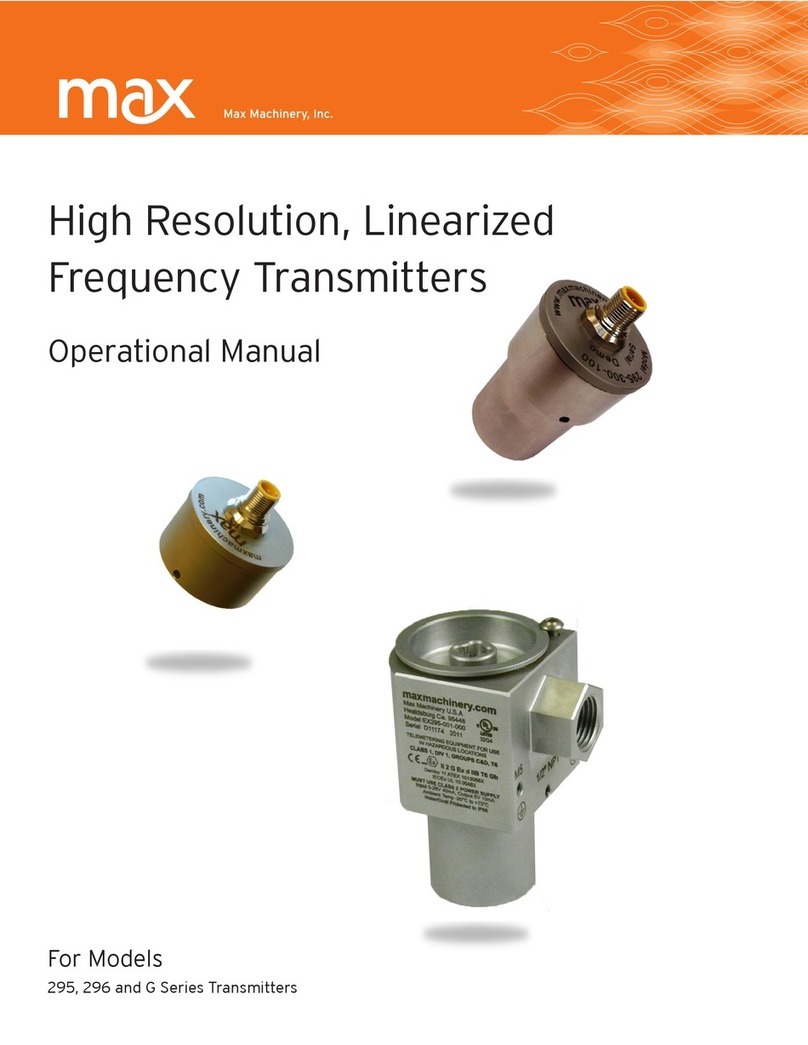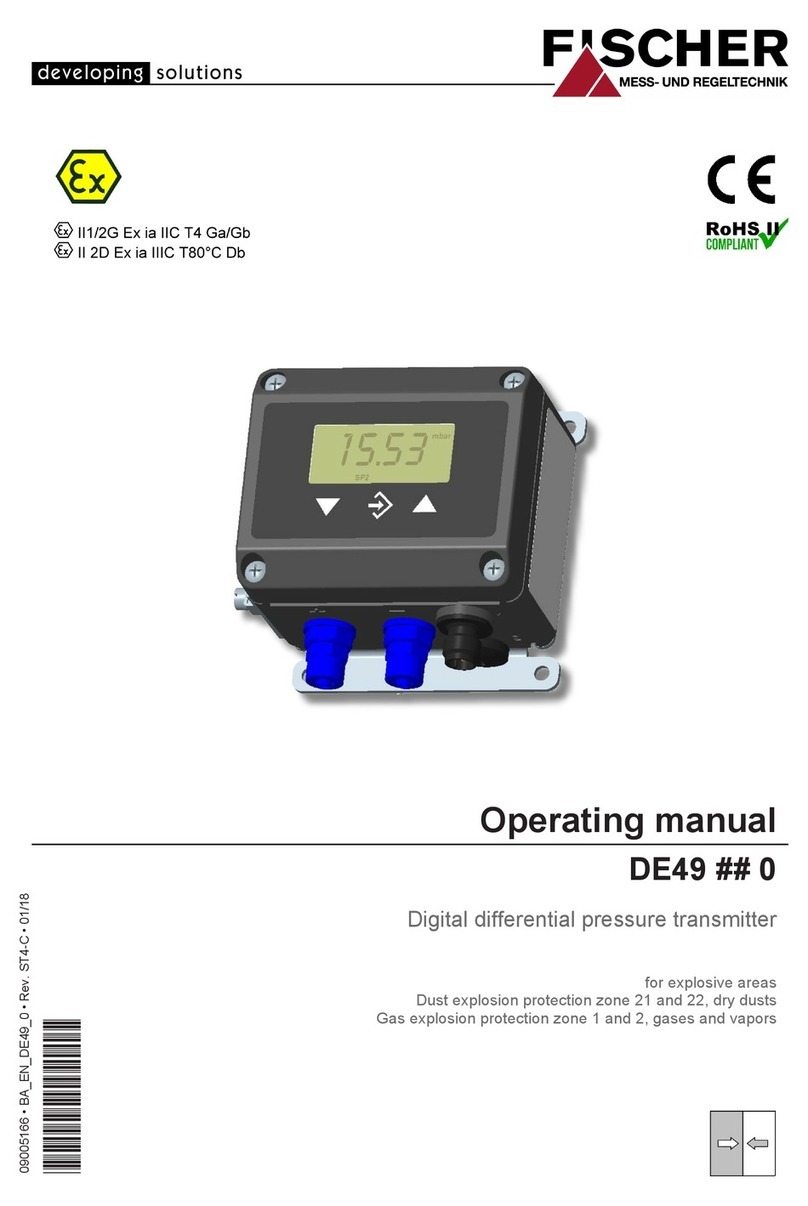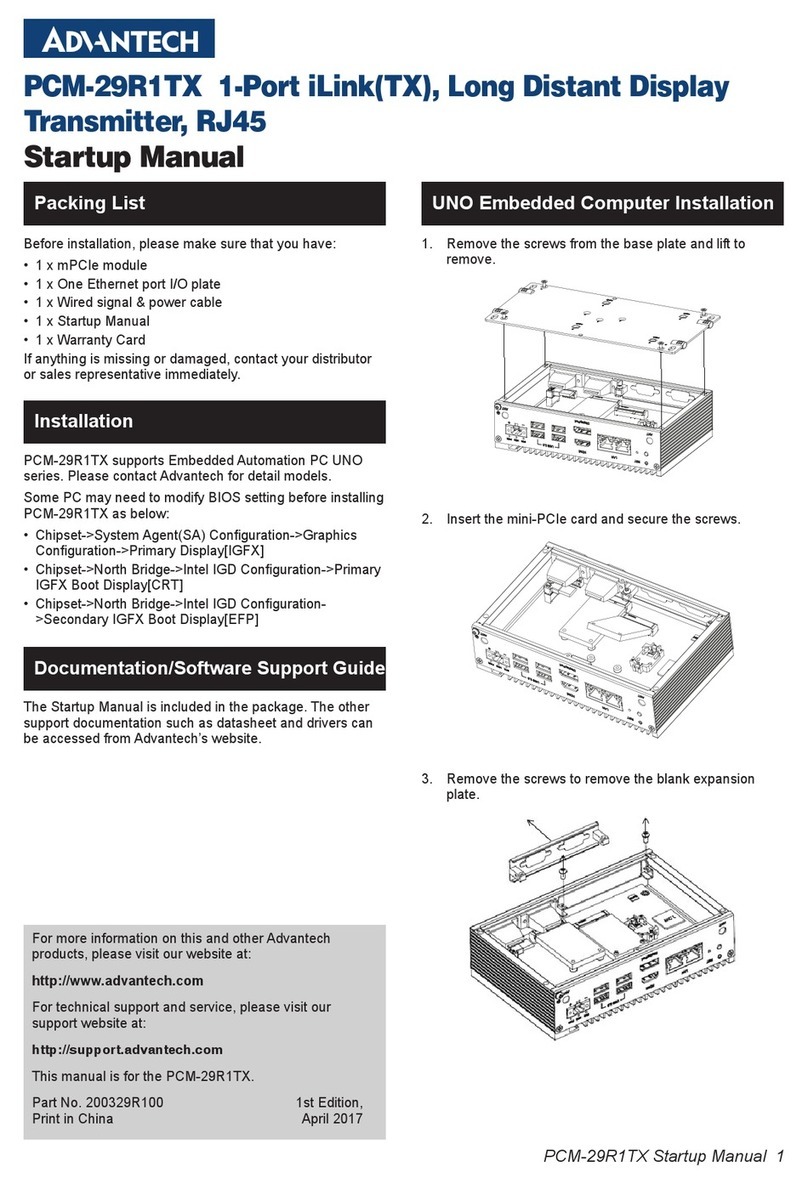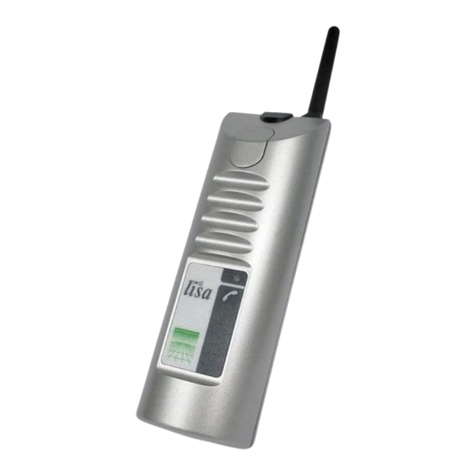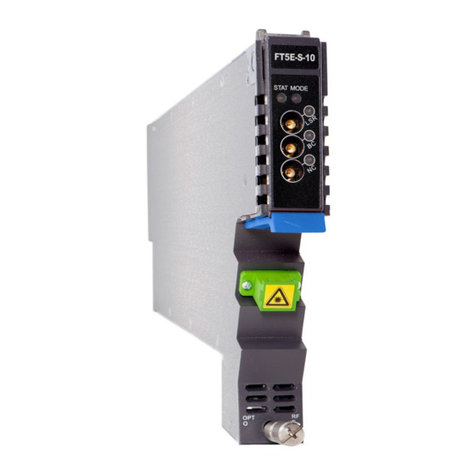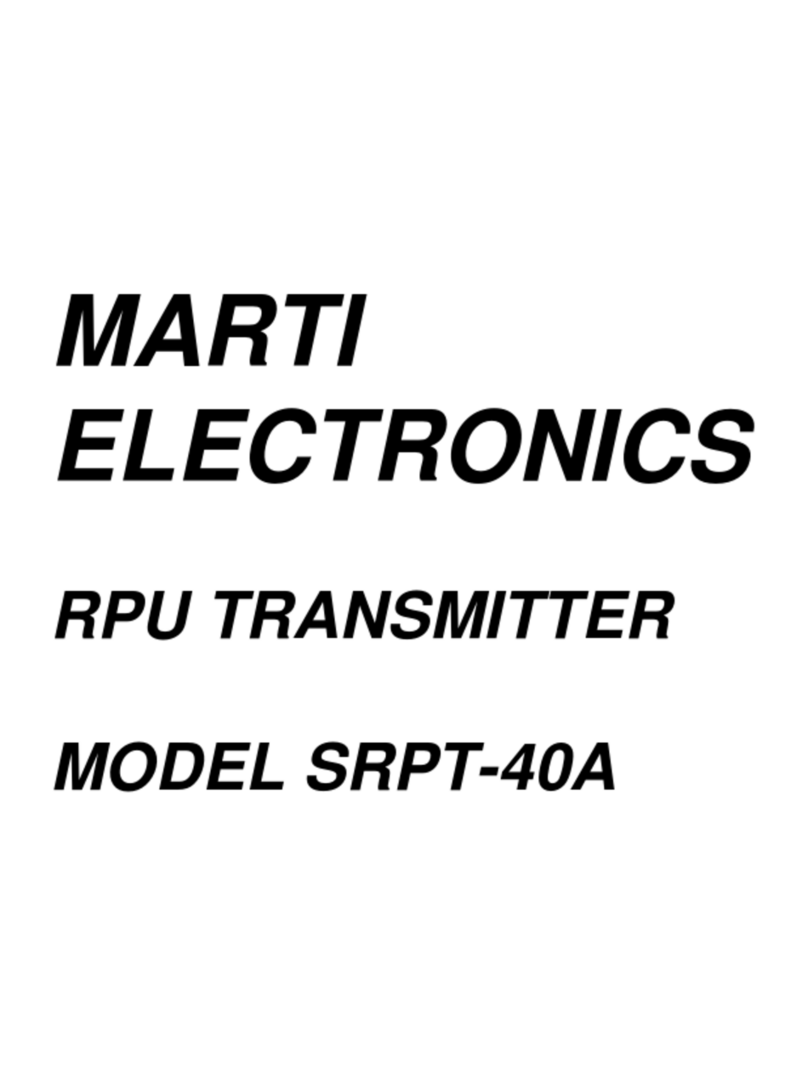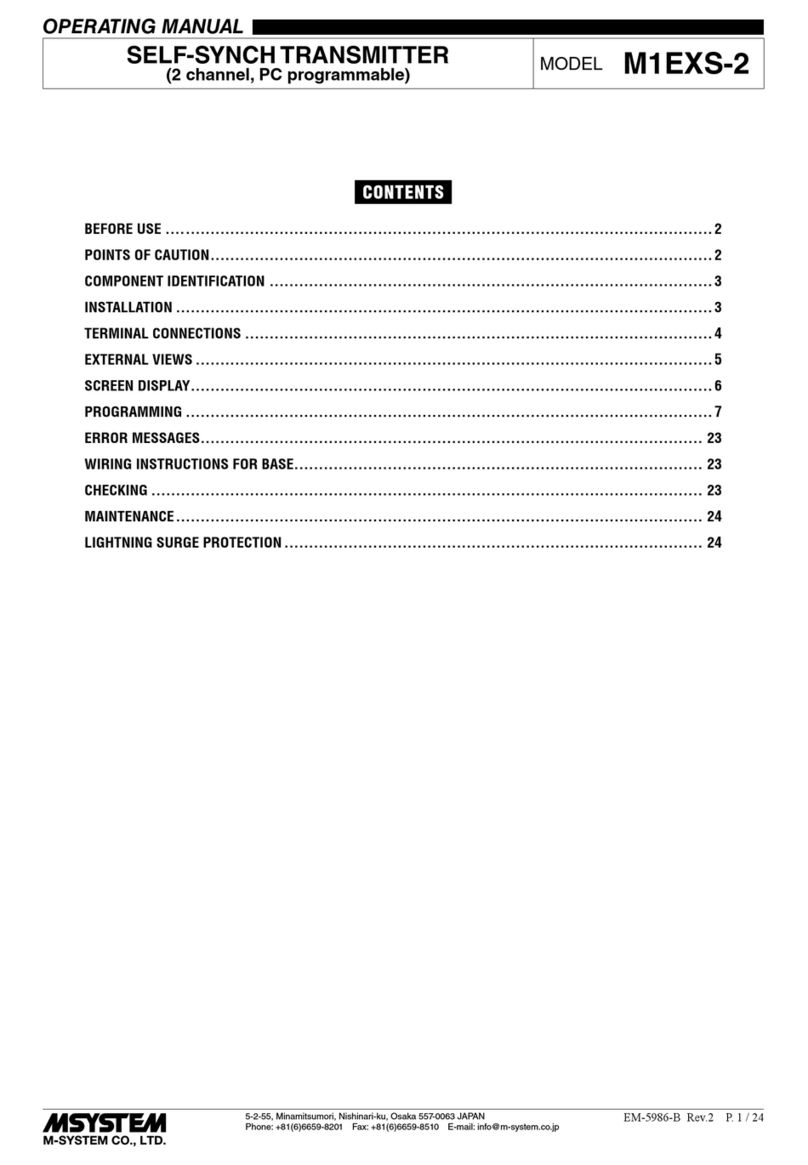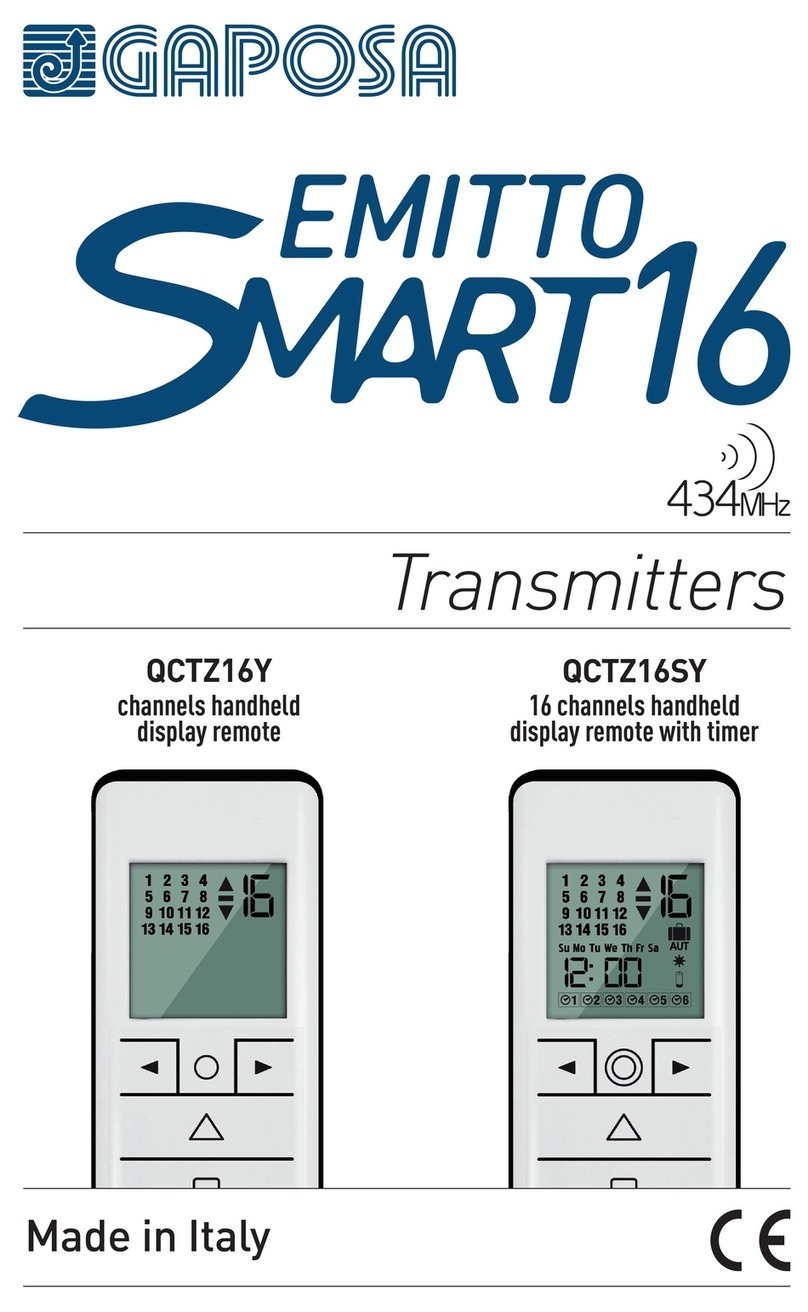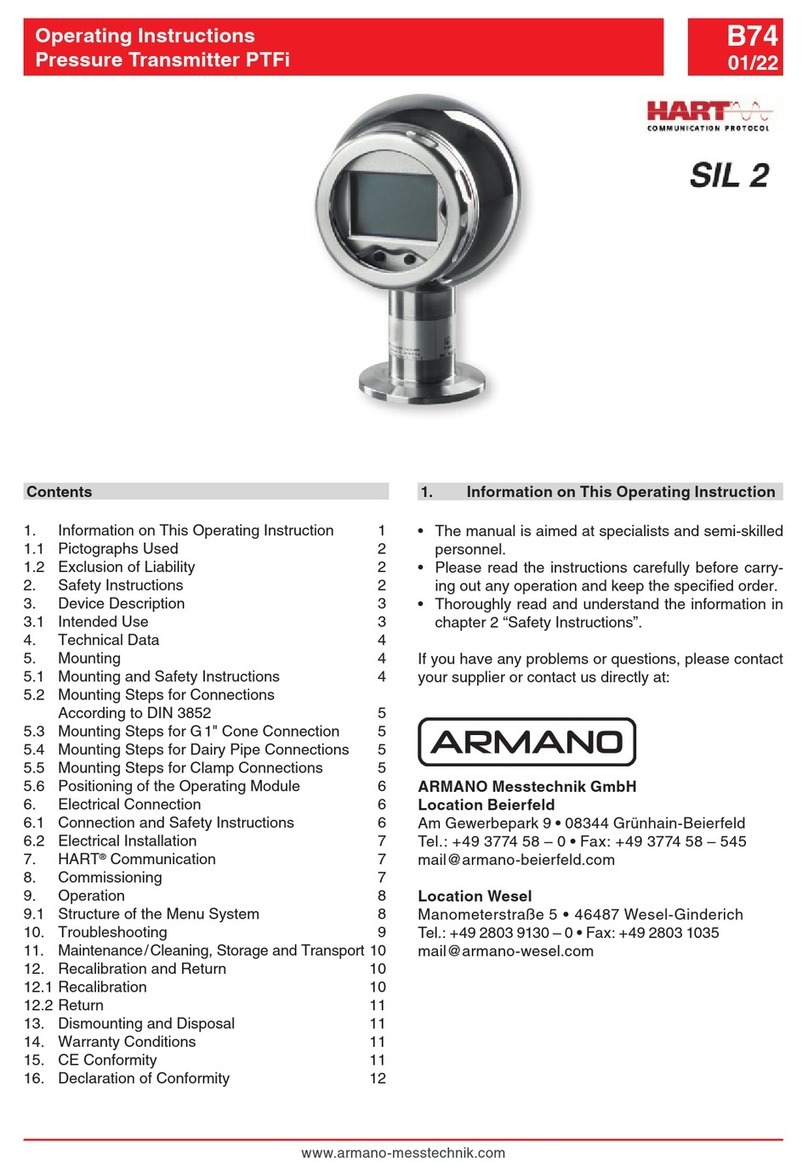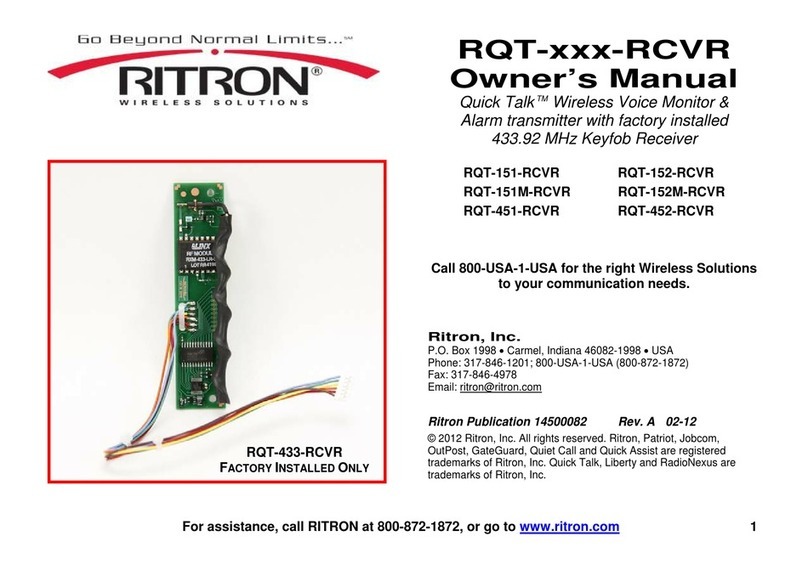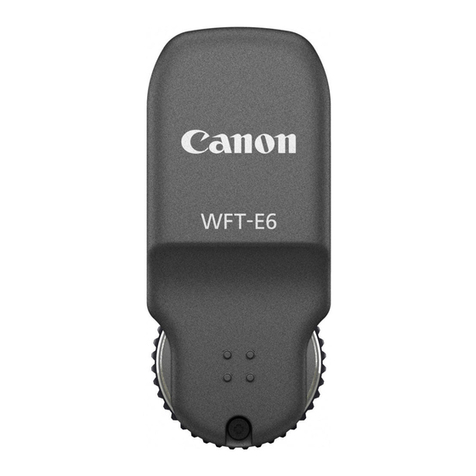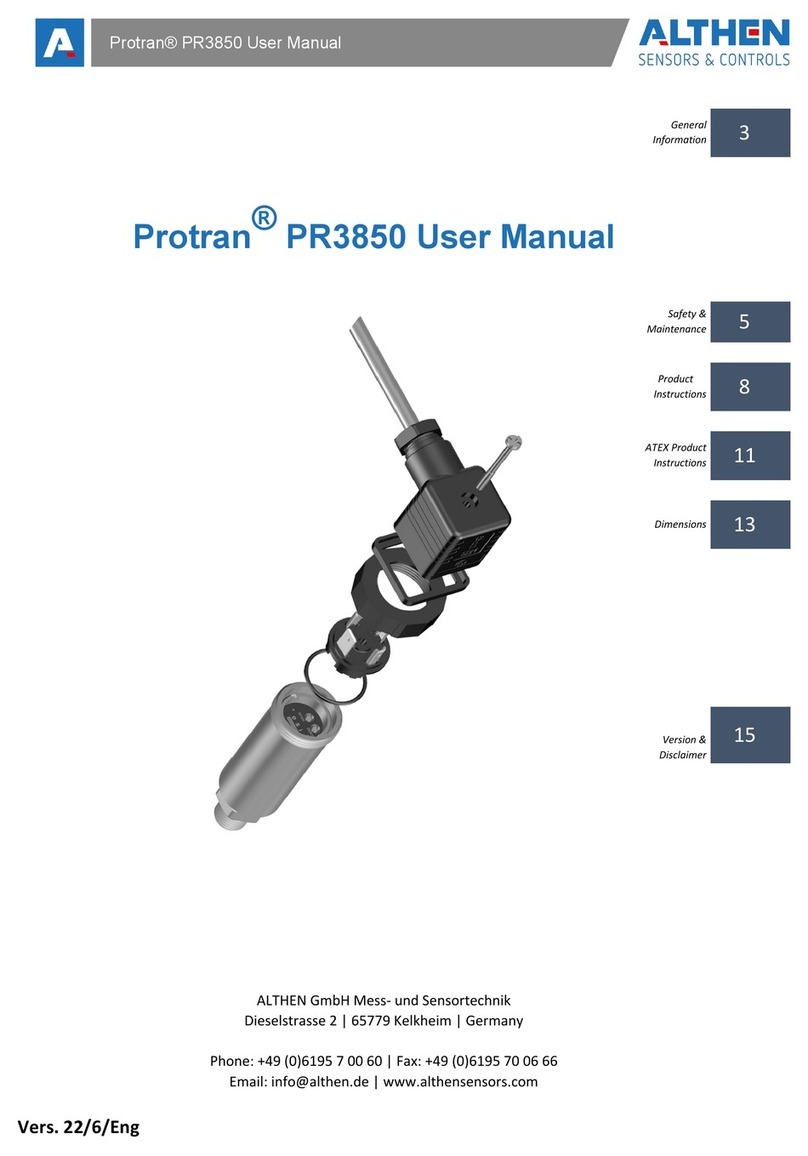Gira 5331 Series User manual

Wireless wall transmitter, 1-gang with inscription space, Wireless wall
transmitter, 3-gang with inscription space
Wireless wall transmitter, 1-gang with inscription space
Order no.: 5331..
Wireless wall transmitter, 3-gang with inscription space
Order no.: 5333 ..
User manual
1 Safety instructions
Electrical devices may only be mounted and connected by electrically skilled persons.
Serious injuries, fire or property damage possible. Please read and follow manual fully.
The radio communication takes place via a non-exclusively available transmission path, and is
therefore not suitable for safety-related applications, such as emergency stop and emergency
call.
These instructions are an integral part of the product, and must remain with the end customer.
2 Safety instructions for button cells
This device or its accessories are supplied with button cells.
Danger to life! Swallowing buttons can lead to severe internal burns within 2 hours and death.
Keep button cells away from children.
Do not use devices if the battery compartment does not close securely and keep away from
children.
If you suspect that a button cell has been swallowed or is in a part of the body, seek immediate
medical attention.
Risk of chemical burns! Batteries can burst and leak.
Do not short-circuit batteries. Replace batteries only with an identical or equivalent type.
Risk of explosion! Do not throw batteries into fire or recharge batteries.
3 Device components
Figure1: Radio wall transmitter
(1) Radio wall transmitter
(2) Labelling field
(3) Button covers
4 Function
– Radio sensor for transmission of switching, dimming, blind movement and scene com-
mands
1 / 10
32579232 10866127 13.07.2018

Wireless wall transmitter, 1-gang with inscription space, Wireless wall
transmitter, 3-gang with inscription space
– Operation with radio actuators from the eNet system
Product characteristics
– Two adjacent buttons each belong to one channel
– Two-coloured LEDs to the right and left of the buttons for signalling
– The switch-on brightness in combination with dimmer actuators can be saved.
– Battery-powered device
– Signalling of transmission errors can be switched off
– Scenes, radio wall transmitter, 1-gang: All Off, one individual scene
– Scenes, radio wall transmitter, 3-gang: All Off, five individual scenes
Can be set with eNet server:
– Scene All On
– Operation locks
The parameter list is in the Internet in the documentation for this device.
Supplementary functions with eNet Server
– Fully encrypted radio transmission (AES-CCM) from eNet Server software version 2.0
– Update of the device software
– Reading of error memory
5 Operation
When operating with the eNet Server, operation and signalling could vary from what is de-
scribed here.
Function of status LED in operation
As soon as a button is pressed or released, the corresponding status LED first signals radio
communication.
– The status LED lights up red for 3 seconds
and then the actuator status/group status on operation with channel buttons.
– Left status LED turns green for 3 seconds:
At least one actuator is switched on, or one Venetian blind is not in the top end position.
– Right status LED turns green for 3 seconds:
All the actuators are switched off or the Venetian blinds are all in the upper end position.
or the actuator status/group status on operation with scene buttons.
– Status LED turns green for 3 seconds:
At least one actuator is switched on, or one Venetian blind is not in the top end position.
– Status LED remains off:
All the actuators are switched off or the Venetian blinds are all in the upper end position.
If there is no status message from at least one actuator, a transmission error is signaled.
Status LED flashes red quickly for 5 seconds.
Channel assignment of the wall transmitter
Figure2: Channel assignment for operation
2 / 10
32579232 10866127 13.07.2018

Wireless wall transmitter, 1-gang with inscription space, Wireless wall
transmitter, 3-gang with inscription space
Operating light
■ Switching: Press button for less than 0.4 seconds.
■ Dimming: Press the button for longer than 0.4 seconds. The dimming process ends when
the button is released.
■ Switching on dimmer actuators at minimum brightness: Press the right button for longer
than 0.4 seconds.
■ Switching on dimmer actuators at minimum brightness and dimming to maximum bright-
ness: Press the left button for longer than 0.4 seconds.
Operating blind
■ Moving the Venetian blind: Press the button for longer than 1 second.
■ Stopping or adjusting the Venetian blind: Press the button for less than 1 second.
Operating push-button actuator
■ Press the button. The load is switched on for the duration of the button-press.
The maximum actuation length is 60 seconds.
Recalling scenes
■ Press the scene button briefly.
Actuators switching to the saved scene.
Changing scene
■ Press the scene button briefly.
Actuators switching to the saved scene.
■ Setting a new scene
■ Press scene button for longer than 4 seconds.
Actuators first switching to the old scene and save the new scene after 4 seconds.
Save switch-on brightness
With dimmer actuators a brightness value can be saved to which the dimmer actuator switches
after a short button press.
The buttons of a channel are set as channel buttons.
■ Set required switch-on brightness.
■ Press both buttons of a channel simultaneously for longer than 4 seconds.
The light is briefly switched off and switched on again to the switch-on brightness. Switch-
on brightness is saved.
Polling sum status
The buttons of a channel are set as channel buttons.
■ Press both buttons of a channel simultaneously for 1 to 4seconds.
Signalling of radio transmission and group status (see function of the status LED in opera-
tion)
6 Information for electrically skilled persons
Connecting and fitting the device
To ensure good transmission quality, keep a sufficient distance from any possible sources of in-
terference, e.g. metallic surfaces, microwave ovens, hi-fi and TV systems, ballasts or trans-
formers.
Perform commissioning procedures before installation (see chapter Commissioning).
Mount the wall transmitter in the correct position, screw holes at the bottom.
3 / 10
32579232 10866127 13.07.2018

Wireless wall transmitter, 1-gang with inscription space, Wireless wall
transmitter, 3-gang with inscription space
Screw mounting
Figure3: Screw mounting
■ Using a screwdriver, carefully remove the button covers (3).
■ Insert supplied threaded sleeves (5) through the screw holes from the rear.
■ Mount the wall transmitter (1) and frame (6) directly to the wall using the screws (7) and
anchors (4).
■ Attach the button covers.
Glue mounting
In order to glue the wall transmitter directly to an even surface, e.g. glass, a base plate is avail-
able (see accessories).
Figure4: Glue mounting
For multiple combinations with glue mounting, the edge pieces (8) of neighbouring base
plates have to be broken off at the predetermined breaking points.
To ensure good adhesion, the substrate must be flat and free of dust and grease.
■ Glue the base plate (9) (see Accessories chapter) directly to the surface.
■ Using a screwdriver, carefully remove the button covers (3).
■ Fix the wall transmitter (1) and frame (6) with the screws (10).
■ Attach the button covers.
4 / 10
32579232 10866127 13.07.2018

Wireless wall transmitter, 1-gang with inscription space, Wireless wall
transmitter, 3-gang with inscription space
Installation in appliance box
Figure5: Installation in appliance box
■ Use screws to fasten the supporting frame (11) (see Chapter 'Accessories') to the appli-
ance box.
■ Using a screwdriver, carefully remove the button covers (3).
■ Use screws (12) to mount the wall transmitter (1) and frame (6) to the supporting frame).
■ Attach the button covers.
7 Commissioning
Insert battery
WARNING
Batteries can burst and leak.
Risk of chemical burns.
Replace batteries only with an identical or equivalent type.
The battery holder is located on the rear side.
■ Using a screwdriver, carefully remove the button covers and unscrew the device.
Keep contacts of batteries and device free of grease.
■ Apply battery to the positive contact of the battery holder. Observe polarity: the positive
pole of the battery must be at the top.
■ Press gently on battery to snap it in.
The wall transmitter is ready for operation.
DANGER!
Mortal danger of electric shock.
During commissioning, cover the parts carrying voltage on radio transmitters and ac-
tuators and in their surrounding area.
The button combination calls up the programming mode for channels or scenes.
Connecting channel button to radio actuator
Up to 10 radio actuators can be connected to a transmitter in a single step.
5 / 10
32579232 10866127 13.07.2018

Wireless wall transmitter, 1-gang with inscription space, Wireless wall
transmitter, 3-gang with inscription space
Figure6: Activating programming mode for channel buttons
■ Press the top left and bottom right buttons simultaneously for longer than 4 seconds
(Figure 6).
The left red LED flashes slowly. The radio sensor is in programming mode for approx.
1minute.
■ Switch the actuator to programming mode (see actuator instructions).
■ Press the required channel button briefly.
The button is configured as channel button and connected to the actuator. The red LED
lights up for approx. 5seconds. The radio transmitter and actuator exit the programming
mode automatically.
If the red LED of the radio transmitter flashes 3times at 1-second intervals for approx.
5seconds, then the programming operation was not successful. The actuator is outside
radio range, not in programming mode or there are radio faults.
If the status LED of the actuator flashes 3times at 1-second intervals for approx.
5seconds, then the programming operation was not successful. All the memory locations
in the actuator or radio transmitter are occupied.
Press the top left and bottom right button once again simultaneously for longer than 4
seconds to terminate the programming mode earlier.
The All Off button of a radio transmitter is connected to the actuator automatically as soon
as the first connection to a radio transmitter takes place. Scene buttons must be connec-
ted separately.
Connecting scene button to radio actuator
The buttons of the wall transmitter are preallocated with the following scenes:
Release the Button allocation
1 left / 1 right Scene 1 / All Off
2 left / 2 right Scenes 2 / Scene 3
3 left / 3 right Scenes 4 / Scene 5
Figure7: Activating programming mode for scene buttons
6 / 10
32579232 10866127 13.07.2018

Wireless wall transmitter, 1-gang with inscription space, Wireless wall
transmitter, 3-gang with inscription space
■ Press the top right and bottom left buttons simultaneously for 4 seconds (Figure 7).
The left red LED flashes slowly. The radio sensor is in programming mode for approx.
1minute.
■ Switch the actuator to programming mode (see actuator instructions).
■ Press the scene button briefly.
The button is configured as scene button and connected to the actuator. The red LED
lights up for approx. 5 seconds. The programming mode is exited automatically.
If the red LED of the radio transmitter flashes 3times at 1-second intervals for approx.
5seconds, then the programming operation was not successful. The actuator is outside
radio range, not in programming mode or there are radio faults.
If the status LED of the actuator flashes 3 times at 1-second intervals for approx. 5
seconds, then the programming operation was not successful. All the memory locations in
the actuator or radio transmitter are occupied.
Press the top left and bottom right button once again simultaneously for longer than 4
seconds to terminate the programming mode earlier.
Disconnecting connection to an actuator
■ Carry out the same steps as when connecting (see the chapter Connecting channel but-
ton to radio actuator or scene button to radio actuator).
The status LED of the actuator flashes quickly for 5 seconds. The actuator is disconnec-
ted from the radio transmitter. The actuator and radio transmitter exit the programming
mode automatically.
If there several connections or scene buttons for an actuator, all the connections must be
disconnected individually.
All On and All Off buttons of a radio transmitter are disconnected automatically as soon as
the last connection to the actuator is disconnected. Manual disconnection is not possible.
Polling button programming
■ Briefly press the top right and bottom left buttons simultaneously (Bild 7).
All functions are terminated.
The left-hand Status LED turns green on programming as channel buttons.
The right-hand Status LED turns green on programming as scene buttons.
Resetting the channel or scene button
The connections to the actuators are disconnected and parameters are reset to default setting.
The connections in the actuators are preserved and must be deleted separately.
■ Press the top left and bottom right buttons simultaneously for longer than 20 seconds
(Figure 6).
The red status LED flashes after 4 seconds. After 20 seconds the LED flashes faster.
■ Press the desired button briefly.
The red LED flashes more slowly.
The channel button or scene button has been reset. The setting as channel button or
scene button is retained.
Resetting wall transmitter to the default setting
The connections to the actuators are disconnected and parameters are reset to default setting.
The connections in the actuators are preserved and must be deleted separately.
■ Press the top left and bottom right buttons simultaneously for longer than 20 seconds
(Figure 6).
The red status LED flashes after 4 seconds. After 20 seconds the LED flashes faster.
7 / 10
32579232 10866127 13.07.2018

Wireless wall transmitter, 1-gang with inscription space, Wireless wall
transmitter, 3-gang with inscription space
■ Release buttons and press the top left and bottom right buttons simultaneously once
again.
The red LED flashes more slowly for approx. 5 seconds.
The wall transmitter is reset to default setting. All the buttons are set as channel buttons.
8 Appendix
Remove empty batteries immediately and dispose of in an environmentally friendly
manner. Do not throw batteries into household waste. Consult your local authorities
about environmentally friendly disposal. According to statutory provisions, the end
consumer is obligated to return used batteries.
8.1 Technical data
Rated voltage DC 3 V
Battery type 1×Lithium CR 2450N
Ambient temperature -5 ... +45 °C
Degree of protection IP 20
Transmitting range in free field typ. 100 m
Radio frequency 868.0 ... 868.6 MHz
Transmission capacity max. 20 mW
Receiver category 2
8.2 Parameter list
The device parameters can be changed with the eNet Server.
Device configuration
Parameters Setting options
Basic setting
Explanations
Function Rocker
Other modes
Unused
Basic setting: Rocker
Rocker
The channel works as a channel button. Set-
ting is always made in pairs.
Other modes
The channel works as a scene button. Setting
is always made in pairs.
Unused
The channel is not displayed in the eNet
SMART HOME app and is disabled for use in
the commissioning interface.
Operating mode App use, lock-out protec-
tion, forced operation, wind
alarm, sun protection, twi-
light
Setting the type of scene used for a scene but-
ton. Setting is always made in pairs.
8 / 10
32579232 10866127 13.07.2018

Wireless wall transmitter, 1-gang with inscription space, Wireless wall
transmitter, 3-gang with inscription space
Parameters Setting options
Basic setting
Explanations
Basic setting: App use
Advanced device settings
Parameters Setting options
Basic setting
Explanations
Manual commis-
sioning
On, Off
Basic setting: On
Disables manual commissioning for all device
channels. Note: In the "Off" setting, the device
cannot be reset to the factory setting.
Extended channel settings
Parameters Setting options
Basic setting
Explanations
Manual commis-
sioning
On, Off
Basic setting: On
Blocks manual commissioning for the device
channel. Note: In the "Off" setting, the device
cannot be reset to the factory setting.
Local Operation On, Off
Basic setting: On
Blocks the device channel for local operation.
8.3 Troubleshooting
After a button actuation, the status LED of the channel or scene button flashes red slowly for 3
seconds.
Cause: battery in the wall transmitter is almost empty.
Changing the battery (see chapter Commissioning – Inserting the battery).
The receiver does not react and the status LED of the channel or scene button displays a
transmission error. Status LED flashes red quickly for 3 seconds.
Cause 1: Radio range exceeded. Structural obstacles reduce the range.
Using a radio repeater.
Cause 2: Actuator is not ready for operation.
Check the actuator and mains voltage.
Cause 3: There are radio faults, e.g. through outside radio.
Eliminate radio interference.
The actuator causing the transmission error can be removed from the display of transmis-
sion errors. To do this, briefly press the top left and bottom right buttons simultaneously
during signalling. The status LED lights up red. During this time, do not press any button
on the wall transmitter. The actuator is automatically taken into account again when it
transmits a status message after radio transmission.
After a button has been pressed, the status LED flashes red quickly for 3 seconds.
Cause: Maximum permitted transmission period (statutory Duty Cycle Limit) has almost been
reached. For the function of the transmitter to continue, the polling and display of the sum status
will be switched off. As soon as sufficient transmission time is available again, the sum status
will again be polled on button actuation.
Actuate the transmitter again after a short waiting time, normally a few seconds.
Reduce the number of actuations.
Reduce the number of actuators connected to the transmitter.
9 / 10
32579232 10866127 13.07.2018

Wireless wall transmitter, 1-gang with inscription space, Wireless wall
transmitter, 3-gang with inscription space
8.4 Accessories
Mounting plate set 5339 00
Support ring, plastic 5338 00
8.5 Conformity
Gira Giersiepen GmbH & Co. KG hereby declares that the radio system type order no. 5331.. /
5333 .. meets the directive 2014/53/EU. You can find the full article number on the device. The
complete text of the EU Declaration of Conformity is available under the Internet address:
www.gira.de/konformitaet
8.6 Warranty
The warranty follows about the specialty store in between the legal framework as provided for
by law Please submit or send faulty devices postage paid together with an error description to
your responsible salesperson (specialist trade/installation company/electrical specialist trade).
They will forward the devices to the Gira Service Center. They will forward the devices to the
Gira Service Center.
Gira
Giersiepen GmbH & Co. KG
Elektro-Installations-
Systeme
Industriegebiet Mermbach
Dahlienstraße
42477 Radevormwald
Postfach 12 20
42461 Radevormwald
Deutschland
Tel +49(0)21 95 - 602-0
Fax +49(0)21 95 - 602-191
www.gira.de
10 / 10
32579232 10866127 13.07.2018
Other manuals for 5331 Series
1
This manual suits for next models
1
Table of contents
Other Gira Transmitter manuals

